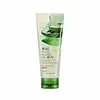What's inside
What's inside
 Key Ingredients
Key Ingredients

 Benefits
Benefits

 Concerns
Concerns

 Ingredients Side-by-side
Ingredients Side-by-side

Water
Skin ConditioningGlycerin
HumectantSodium Cocoyl Alaninate
Disodium Cocoyl Glutamate
CleansingXanthan Gum
EmulsifyingPEG-40 Hydrogenated Castor Oil
EmulsifyingAloe Barbadensis Leaf Extract
EmollientCentella Asiatica Extract
CleansingPolygonum Cuspidatum Root Extract
AntioxidantScutellaria Baicalensis Root Extract
AstringentCamellia Sinensis Leaf Extract
AntimicrobialGlycyrrhiza Glabra Root Extract
BleachingChamomilla Recutita Flower Extract
MaskingRosmarinus Officinalis Leaf Extract
AntimicrobialLauryl Hydroxysultaine
CleansingSodium Cocoyl Glutamate
CleansingPotassium Cocoyl Glycinate
Caprylyl Glycol
EmollientPotassium Cocoate
EmulsifyingCitric Acid
BufferingButylene Glycol
HumectantTrisodium EDTA
Sodium Benzoate
MaskingParfum
MaskingLinalool
PerfumingLimonene
PerfumingWater, Glycerin, Sodium Cocoyl Alaninate, Disodium Cocoyl Glutamate, Xanthan Gum, PEG-40 Hydrogenated Castor Oil, Aloe Barbadensis Leaf Extract, Centella Asiatica Extract, Polygonum Cuspidatum Root Extract, Scutellaria Baicalensis Root Extract, Camellia Sinensis Leaf Extract, Glycyrrhiza Glabra Root Extract, Chamomilla Recutita Flower Extract, Rosmarinus Officinalis Leaf Extract, Lauryl Hydroxysultaine, Sodium Cocoyl Glutamate, Potassium Cocoyl Glycinate, Caprylyl Glycol, Potassium Cocoate, Citric Acid, Butylene Glycol, Trisodium EDTA, Sodium Benzoate, Parfum, Linalool, Limonene
Water
Skin ConditioningCocamidopropyl Betaine
CleansingDecyl Glucoside
CleansingGlycerin
HumectantDisodium Cocoyl Glutamate
CleansingTriethanolamine
BufferingSodium Ascorbyl Phosphate
AntioxidantCitric Acid
BufferingCitrullus Lanatus Fruit Extract
Skin ConditioningCucumis Sativus Fruit Extract
EmollientAloe Barbadensis Extract
Skin ConditioningMentha Piperita Oil
MaskingTocopheryl Acetate
AntioxidantPEG-40 Hydrogenated Castor Oil
EmulsifyingMenthol
MaskingAcrylates/C10-30 Alkyl Acrylate Crosspolymer
Emulsion StabilisingXanthan Gum
EmulsifyingPanthenol
Skin ConditioningBenzyl Alcohol
PerfumingEthylhexylglycerin
Skin ConditioningTocopherol
AntioxidantDisodium EDTA
CI 16185
Cosmetic ColorantWater, Cocamidopropyl Betaine, Decyl Glucoside, Glycerin, Disodium Cocoyl Glutamate, Triethanolamine, Sodium Ascorbyl Phosphate, Citric Acid, Citrullus Lanatus Fruit Extract, Cucumis Sativus Fruit Extract, Aloe Barbadensis Extract, Mentha Piperita Oil, Tocopheryl Acetate, PEG-40 Hydrogenated Castor Oil, Menthol, Acrylates/C10-30 Alkyl Acrylate Crosspolymer, Xanthan Gum, Panthenol, Benzyl Alcohol, Ethylhexylglycerin, Tocopherol, Disodium EDTA, CI 16185
Ingredients Explained
These ingredients are found in both products.
Ingredients higher up in an ingredient list are typically present in a larger amount.
Citric Acid is an alpha hydroxy acid (AHA) naturally found in citrus fruits like oranges, lemons, and limes.
Like other AHAs, citric acid can exfoliate skin by breaking down the bonds that hold dead skin cells together. This helps reveal smoother and brighter skin underneath.
However, this exfoliating effect only happens at high concentrations (20%) which can be hard to find in cosmetic products.
Due to this, citric acid is usually included in small amounts as a pH adjuster. This helps keep products slightly more acidic and compatible with skin's natural pH.
In skincare formulas, citric acid can:
While it can provide some skin benefits, research shows lactic acid and glycolic acid are generally more effective and less irritating exfoliants.
Most citric acid used in skincare today is made by fermenting sugars (usually from molasses). This synthetic version is identical to the natural citrus form but easier to stabilize and use in formulations.
Read more about some other popular AHA's here:
Learn more about Citric AcidWe don't have a description for Disodium Cocoyl Glutamate yet.
Glycerin is already naturally found in your skin. It helps moisturize and protect your skin.
A study from 2016 found glycerin to be more effective as a humectant than AHAs and hyaluronic acid.
As a humectant, it helps the skin stay hydrated by pulling moisture to your skin. The low molecular weight of glycerin allows it to pull moisture into the deeper layers of your skin.
Hydrated skin improves your skin barrier; Your skin barrier helps protect against irritants and bacteria.
Glycerin has also been found to have antimicrobial and antiviral properties. Due to these properties, glycerin is often used in wound and burn treatments.
In cosmetics, glycerin is usually derived from plants such as soybean or palm. However, it can also be sourced from animals, such as tallow or animal fat.
This ingredient is organic, colorless, odorless, and non-toxic.
Glycerin is the name for this ingredient in American English. British English uses Glycerol/Glycerine.
Learn more about GlycerinPeg-40 Hydrogenated Castor Oil is derived from castor oil and polyethylene glycol (PEG). It is used as a emollient and emulsifier.
As an emulsifier, it helps prevent ingredients from separating. It also helps make the other ingredients more soluble; it is often used to solubilize fragrances. This increases spreadability and elongates shelf life in a product.
Emollients help soothe and soften the skin. They do this by creating a protective film on your skin. This barrier helps trap moisture and keeps your skin hydrated. Emollients may be effective at treating dry or itchy skin.
This ingredient may or may not be vegan, depending on the source.
Peg-40 Hydrogenated Castor Oil may not be fungal-acne safe. We recommend speaking with a professional if you have any questions or concerns.
Learn more about PEG-40 Hydrogenated Castor OilWater. It's the most common cosmetic ingredient of all. You'll usually see it at the top of ingredient lists, meaning that it makes up the largest part of the product.
So why is it so popular? Water most often acts as a solvent - this means that it helps dissolve other ingredients into the formulation.
You'll also recognize water as that liquid we all need to stay alive. If you see this, drink a glass of water. Stay hydrated!
Learn more about WaterXanthan gum is used as a stabilizer and thickener within cosmetic products. It helps give products a sticky, thick feeling - preventing them from being too runny.
On the technical side of things, xanthan gum is a polysaccharide - a combination consisting of multiple sugar molecules bonded together.
Xanthan gum is a pretty common and great ingredient. It is a natural, non-toxic, non-irritating ingredient that is also commonly used in food products.
Learn more about Xanthan Gum